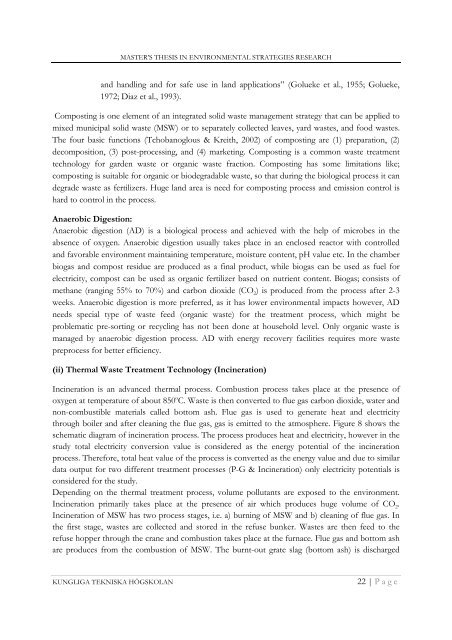Technical Development of Waste Sector in Sweden: Survey
Technical Development of Waste Sector in Sweden: Survey
Technical Development of Waste Sector in Sweden: Survey
You also want an ePaper? Increase the reach of your titles
YUMPU automatically turns print PDFs into web optimized ePapers that Google loves.
MASTER’S THESIS IN ENVIRONMENTAL STRATEGIES RESEARCH<br />
and handl<strong>in</strong>g and for safe use <strong>in</strong> land applications” (Golueke et al., 1955; Golueke,<br />
1972; Diaz et al., 1993).<br />
Compost<strong>in</strong>g is one element <strong>of</strong> an <strong>in</strong>tegrated solid waste management strategy that can be applied to<br />
mixed municipal solid waste (MSW) or to separately collected leaves, yard wastes, and food wastes.<br />
The four basic functions (Tchobanoglous & Kreith, 2002) <strong>of</strong> compost<strong>in</strong>g are (1) preparation, (2)<br />
decomposition, (3) post-process<strong>in</strong>g, and (4) market<strong>in</strong>g. Compost<strong>in</strong>g is a common waste treatment<br />
technology for garden waste or organic waste fraction. Compost<strong>in</strong>g has some limitations like;<br />
compost<strong>in</strong>g is suitable for organic or biodegradable waste, so that dur<strong>in</strong>g the biological process it can<br />
degrade waste as fertilizers. Huge land area is need for compost<strong>in</strong>g process and emission control is<br />
hard to control <strong>in</strong> the process.<br />
Anaerobic Digestion:<br />
Anaerobic digestion (AD) is a biological process and achieved with the help <strong>of</strong> microbes <strong>in</strong> the<br />
absence <strong>of</strong> oxygen. Anaerobic digestion usually takes place <strong>in</strong> an enclosed reactor with controlled<br />
and favorable environment ma<strong>in</strong>ta<strong>in</strong><strong>in</strong>g temperature, moisture content, pH value etc. In the chamber<br />
biogas and compost residue are produced as a f<strong>in</strong>al product, while biogas can be used as fuel for<br />
electricity, compost can be used as organic fertilizer based on nutrient content. Biogas; consists <strong>of</strong><br />
methane (rang<strong>in</strong>g 55% to 70%) and carbon dioxide (CO 2 ) is produced from the process after 2-3<br />
weeks. Anaerobic digestion is more preferred, as it has lower environmental impacts however, AD<br />
needs special type <strong>of</strong> waste feed (organic waste) for the treatment process, which might be<br />
problematic pre-sort<strong>in</strong>g or recycl<strong>in</strong>g has not been done at household level. Only organic waste is<br />
managed by anaerobic digestion process. AD with energy recovery facilities requires more waste<br />
preprocess for better efficiency.<br />
(ii) Thermal <strong>Waste</strong> Treatment Technology (Inc<strong>in</strong>eration)<br />
Inc<strong>in</strong>eration is an advanced thermal process. Combustion process takes place at the presence <strong>of</strong><br />
oxygen at temperature <strong>of</strong> about 850 o C. <strong>Waste</strong> is then converted to flue gas carbon dioxide, water and<br />
non-combustible materials called bottom ash. Flue gas is used to generate heat and electricity<br />
through boiler and after clean<strong>in</strong>g the flue gas, gas is emitted to the atmosphere. Figure 8 shows the<br />
schematic diagram <strong>of</strong> <strong>in</strong>c<strong>in</strong>eration process. The process produces heat and electricity, however <strong>in</strong> the<br />
study total electricity conversion value is considered as the energy potential <strong>of</strong> the <strong>in</strong>c<strong>in</strong>eration<br />
process. Therefore, total heat value <strong>of</strong> the process is converted as the energy value and due to similar<br />
data output for two different treatment processes (P-G & Inc<strong>in</strong>eration) only electricity potentials is<br />
considered for the study.<br />
Depend<strong>in</strong>g on the thermal treatment process, volume pollutants are exposed to the environment.<br />
Inc<strong>in</strong>eration primarily takes place at the presence <strong>of</strong> air which produces huge volume <strong>of</strong> CO 2 .<br />
Inc<strong>in</strong>eration <strong>of</strong> MSW has two process stages, i.e. a) burn<strong>in</strong>g <strong>of</strong> MSW and b) clean<strong>in</strong>g <strong>of</strong> flue gas. In<br />
the first stage, wastes are collected and stored <strong>in</strong> the refuse bunker. <strong>Waste</strong>s are then feed to the<br />
refuse hopper through the crane and combustion takes place at the furnace. Flue gas and bottom ash<br />
are produces from the combustion <strong>of</strong> MSW. The burnt-out grate slag (bottom ash) is discharged<br />
KUNGLIGA TEKNISKA HÖGSKOLAN<br />
22 | Page
















